Ideal for greenhouses, early maturing and high-yielding tomato "Blagovest": how to grow it correctly
Tomato Blagovest is considered one of the best greenhouse varieties because of its high yield and resistance to a number of diseases affecting the Solanaceae family.
The excellent appearance of the fruits and their ability for long-term transportation allows the crop to be transported to any retail outlet without losing its presentation. Another great advantage is its early maturity. Read about these and other features of a tomato with a photo in our article.
The content of the article
Characteristics and description of the variety
The Blagovest tomato variety was bred by domestic scientists. This is one of the best indoor tomato crop examples.
In 1994, the Gavrish agricultural company filed an application for registration in the State Register of the selection species Blagovest. And in the next 15 years, his F1 hybrid will become the company's trademark.
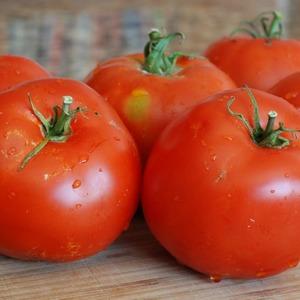 The main difference between the F1 hybrid and the variety is its high yield: up to 6.5 kg from one bush with a ripening period of 95 days.
The main difference between the F1 hybrid and the variety is its high yield: up to 6.5 kg from one bush with a ripening period of 95 days.
The variety has an advantage over the hybrid in that it is able to transmit genetic data through the seeds, while Blagovest F1 does not have this ability.
The species belongs to determinant, despite the fact that the bushes grow up to 1.8 meters. This height requires a mandatory garter. Not only a bush is tied up, but also brushes with fruits. Up to eight fruits are tied on one hand.
Leaves are grayish-green in color, medium in size, usual shape.
The culture belongs to the early maturing. From planting seeds to ripening of fruits, 100-107 days pass.
The variety is resistant to tobacco mosaic virus and late blight... Possesses increased resistance to insect pests: spider mites, Colorado beetles, wireworms, bear.
The shape of the vegetable is round, the color of unripe tomatoes is white-green, in ripe ones - a pronounced bright red hue. The average weight of a tomato is 100-120 g, but this weight is not the limit and can increase up to 150 g.
Productivity - up to 5 kg per bush, and 16-17 kg per 1 sq. m.
The purpose of vegetables is universal: from fresh application to marinades, salting and preparation of tomato products.
The presentation is excellent. Fresh tomatoes are stored for a long time.
There are varieties of tomatoes similar to Blagovest, according to such characteristics as a high rate of fruiting and early maturity of fruits. High-yielding varieties include: Market King, Stolypin and Lazy. Early ripening crops are Fat Jack, Baron and Dubrava. And such species as Eupator and Verlioka were bred by the same agricultural firm "Gavrish", which is the creator of Blagovest.
How to grow seedlings
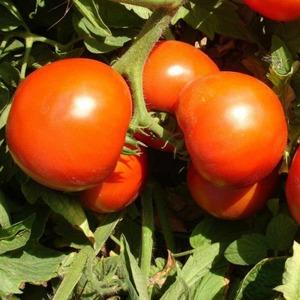 The weather conditions of the region affect the time of planting seeds. The optimum seedling age is 1.5 months. Before sowing seed check for germination in a saline solution - those that surfaced are unsuitable for growing.
The weather conditions of the region affect the time of planting seeds. The optimum seedling age is 1.5 months. Before sowing seed check for germination in a saline solution - those that surfaced are unsuitable for growing.
The seeds are placed in wooden boxes filled with nutritious soil to a depth of 1.5 cm with a distance of 5 cm between them. The soil mixture is prepared by combining in equal proportions humus and sod land. You can also add a little sawdust or peat here.
To disinfect the soil, it is poured with boiling water. After 2 weeks, the soil is ready for sowing. During this time, bacteria useful for the plant have time to multiply.
Council.Before sowing, it is recommended to soak the seeds in warm water for a day.
The Fitosporin solution stimulates the germination of seed material.1 drop of the preparation is added to 100 ml of water and the seeds are left for 2 hours.
At the end of planting, the seeds are sprinkled with earth, watered with warm water and the containers are covered with glass or film.
Important! The first 7 days the seedlings are kept in the dark.
When shoots appear, the covering material is removed from the boxes. At an air temperature of 25-30 degrees Celsius, the first shoots will appear in a few days. After the appearance of 2-4 leaves, the seedlings dive into separate containers with a volume of at least 500 g. From this moment, care consists in watering and monitoring the seedlings.
The soil should not dry out, but it is also not necessary to overmoisten it. Seedlings need at least 12 hours of daylight hours. For this, the seedlings are transferred to a sunny place or provide additional lighting.
During the pick, the first fertilizing is carried out with mineral fertilizer. Thereafter, every 14 days sprouts feed complex fertilizers - for example, Fertikoy Lux. To prepare the solution is simple: 1 tbsp. l. 10 liters of water.
Organics are well suited as top dressing: infusions of mullein, weeds or droppings, but this option is only suitable if the seedlings are in a greenhouse. There will be a very unpleasant smell in the apartment from such fertilizers.
After 45 days, the seedlings are hardened. During the day, the sprouts are put outside for 1-2 hours, at night they should still be indoors, but the air temperature drops to 12-13 degrees Celsius. Exposure to air gradually increases to a day.
Features of planting and growing tomato Blagovest
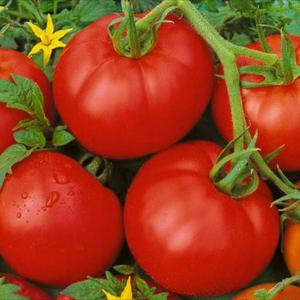 For this culture, the planting scheme is as follows: 40 cm in a row and 60 cm between rows. A bucket of humus and a glass of wood ash are brought into the dug up earth for each square meter.
For this culture, the planting scheme is as follows: 40 cm in a row and 60 cm between rows. A bucket of humus and a glass of wood ash are brought into the dug up earth for each square meter.
Seedlings are well watered before planting. Since the bushes grow tall and sprawling, it is not recommended to plant 1 sq. m more than three seedlings. During the period of flowering and the formation of fruits, the plants must be fed with complex fertilizer and watered only with warm water.
As for abundant watering, it should be carried out only during:
- flowering;
- ovary formation;
- ripening vegetables.
Watering infrequently, in the heat - 2 times a week, 3-4 liters under a bush. After watering, it is imperative to loosen and remove weeds. Mulched the soil dries out more slowly, it will have to be watered less often.
Watering and feeding determine the active growth and quantitative result of the tomato.
The first feeding is carried out two weeks after transplanting tomatoes into the greenhouse. Nitrogen fertilizers are used carefully and in small quantities, as they provoke the development of green mass. It is more useful to feed the plant with phosphorus and potassium. A solution is prepared on the basis of potassium sulfate: 40 g per 10 liters of water.
Reference. Due to the close location of the root system to the soil surface, loosening must be done carefully. Fertilize only after watering to avoid scalding the roots.
A few days after disembarkation, pinching begins. It is recommended to grow this type of tomato in 1-2 stems. However, we recommend focusing on the climatic features of the region: in a short, rainy or hot summer, the results are more indicative when a plant is formed in 1 stem. When long and warm - in 2 or 3 stems.
Formation methods:
- In 1 stem. All stepsons are removed.
- 2 stems. Remove all stepsons up to the first brush. Leave one immediately above her. Then all stepsons are removed on these two stems.
- 3 stems. The same as in 2 stems. The third stem is grown from the stepson closest to the flower cluster.
The plant shows the greatest efficiency when formed in two stems.
Note. In the northern regions, at a height of 2 m, the crown of the stem is cut off, thus stopping its growth. In the southern regions, it is left, letting it grow on the roof of the greenhouse.
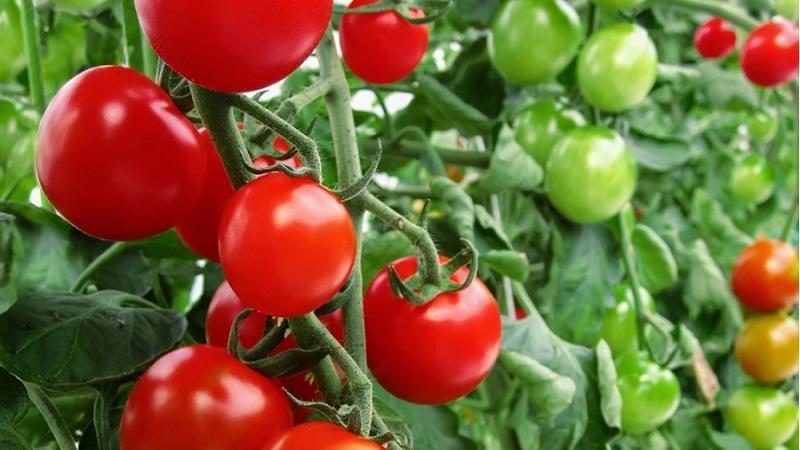
Diseases and pests
The plant is resistant to the main diseases of the nightshade family, such as late blight, tobacco mosaic. It is also rarely attacked by pests.
The main disadvantage of the tomato crop is the susceptibility of leaves to curl, in which the plant changes its color. It brightens, and the top becomes curly. This is a viral disease and cannot be treated. All that can be done here is to remove diseased bushes, and disinfect the soil with copper-containing preparations - for example, Bordeaux liquid.
Regular inspection of the bushes for the presence of pests will help prevent the threat from the insect world in time. Despite the resistance of this species to the Colorado beetle or bear, the vigilance of the gardener will not be superfluous.
The nuances of growing in an open field and a greenhouse
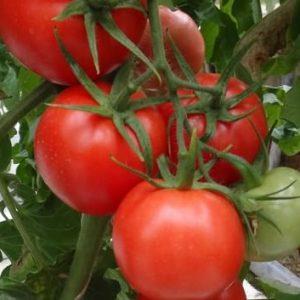 The variety was created specifically for indoor use. For unprotected areas, this type is practically not suitable. Fruiting will be minimal here, and tomatoes will not acquire their real taste, since this process is highly dependent on air temperature and precipitation.
The variety was created specifically for indoor use. For unprotected areas, this type is practically not suitable. Fruiting will be minimal here, and tomatoes will not acquire their real taste, since this process is highly dependent on air temperature and precipitation.
In direct sunlight, young bushes will receive severe burns, even despite prolonged hardening before planting in open ground. Subsequently, they will recover, but fruiting will drag on indefinitely.
Therefore, it is not recommended to expose a variety bred for closed ground to conditions that are unacceptable for it.
Harvesting and application of the crop
Harvesting begins both fully ripe and immature. Vegetables ripen well at home. To do this, just lay them out on a sunny windowsill.
Ripe vegetables are widely used in a wide variety of dishes. They make salads, juices, sauces, pizza, mashed potatoes. Medium and small tomatoes can be preserved whole, while large ones are good for winter preparations: lecho, ketchup, vegetable caviar, adjika, etc.
Advantages and disadvantages of the variety
As a result of selection, the Blagovest variety contains many positive characteristics:
- almost 100% seed germination;
- early maturation;
- high resistance to disease;
- long storage of fruits;
- excellent transportability;
- safety of the presentation for a long time;
- universal use of vegetables.
However, the variety also has some disadvantages:
- cultivation of this culture is possible only in greenhouse conditions;
- a garter of bushes and brushes is required;
- pinching is required;
- plant susceptibility to a viral disease - leaf curl.
Farmers reviews
There are a lot of reviews about the greenhouse tomato culture. As a rule, there are no complaints about the taste of fruits and yield. Basically, summer residents are confused by the fact that the variety is not intended for open ground - and in greenhouses, as you know, the possibility of diseases increases, which requires additional care.
However, for many farmers, he is a "workhorse" and generates considerable income. Which, however, is not surprising: it was for these purposes that this variety of tomatoes was bred.
Elena, Irkutsk:“I bought seeds of Blagovest F1 for planting in the country. Sowed them in the second half of April, a week later saw the first shoots. There were few stepsons - the main thing was to remove them on time. I tied up the bushes at a height of 0.5 m. The fruits ripened sweet and fragrant. "
Galina, Saratov: “Blagovest decided to plant tomatoes for the first time. The bushes grew tall, more than 150 cm. The tomatoes are tasty, large. I made salads and various preserves out of them. The vegetables were not sick at all, which made me very happy ”.
Conclusion
The name Blagovest combines two words - good news. It is not for nothing that this variety has received such a name: the combination of excellent taste, the universal use of vegetables, resistance to diseases, high yield and excellent transportability make this crop a welcome guest in every greenhouse.